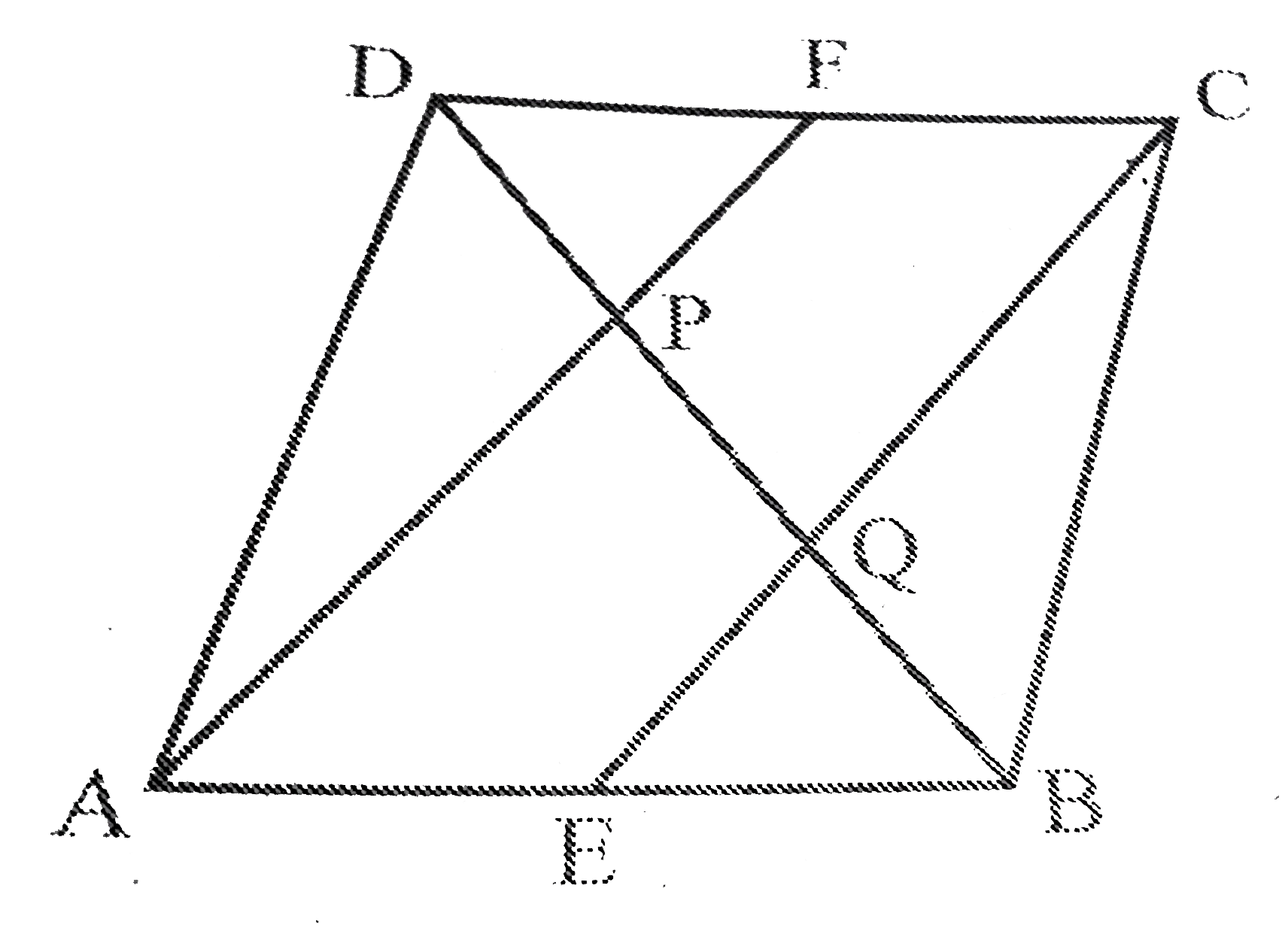Let ABCD be a square with sides of unit lenght. Points E and F are taken on sides AB and AD, respectively,so that AE=AF. Let P be a point inside the squre ABCD.
The value of (PA)2−(PB)2+(PC)2−(PD)2 is equal to
3
2
1
0
The correct Answer is:D
To solve the problem, we will follow these steps:
1. Define the Coordinates of the Square:
Let the square ABCD have vertices at the following coordinates:
- A(0, 0)
- B(1, 0)
- C(1, 1)
- D(0, 1)
2. Define the Points E and F:
Since points E and F are on sides AB and AD respectively, and AE = AF, we can denote the length of AE and AF as x. Therefore:
- E(0, x)
- F(x, 0)
3. Define the Point P Inside the Square:
Let the coordinates of point P be (p_x, p_y), where 0<px<1 and 0<py<1.
4. Calculate the Distances PA, PB, PC, and PD:
Using the distance formula d=√(x2−x1)2+(y2−y1)2:
- PA=√(px−0)2+(py−0)2=√p2x+p2y
- PB=√(px−1)2+(py−0)2=√(px−1)2+p2y
- PC=√(px−1)2+(py−1)2=√(px−1)2+(py−1)2
- PD=√(px−0)2+(py−1)2=√p2x+(py−1)2
5. Calculate (PA)2−(PB)2+(PC)2−(PD)2:
Now we will compute each term:
- PA2=p2x+p2y
- PB2=(px−1)2+p2y=p2x−2px+1+p2y
- PC2=(px−1)2+(py−1)2=p2x−2px+1+p2y−2py+1
- PD2=p2x+(py−1)2=p2x+p2y−2py+1
Now substituting these into our expression:
(PA)2−(PB)2+(PC)2−(PD)2=(p2x+p2y)−(p2x−2px+1+p2y)+(p2x−2px+1+p2y−2py+1)−(p2x+p2y−2py+1)
Simplifying this:
=p2x+p2y−(p2x−2px+1+p2y)+(p2x−2px+1+p2y−2py+1)−(p2x+p2y−2py+1)
=p2x+p2y−p2x+2px−1−p2y+p2x−2px+1+p2y−2py+1−p2x−p2y+2py−1
=0
6. Conclusion:
Thus, the value of (PA)2−(PB)2+(PC)2−(PD)2 is equal to 0.
Final Answer:
The value is 0.
Let the square ABCD have vertices at the following coordinates:
- A(0, 0)
- B(1, 0)
- C(1, 1)
- D(0, 1)
Since points E and F are on sides AB and AD respectively, and AE = AF, we can denote the length of AE and AF as x. Therefore:
- E(0, x)
- F(x, 0)
Let the coordinates of point P be (p_x, p_y), where 0<px<1 and 0<py<1.
Using the distance formula d=√(x2−x1)2+(y2−y1)2:
- PA=√(px−0)2+(py−0)2=√p2x+p2y
- PB=√(px−1)2+(py−0)2=√(px−1)2+p2y
- PC=√(px−1)2+(py−1)2=√(px−1)2+(py−1)2
- PD=√(px−0)2+(py−1)2=√p2x+(py−1)2
Now we will compute each term:
- PA2=p2x+p2y
- PB2=(px−1)2+p2y=p2x−2px+1+p2y
- PC2=(px−1)2+(py−1)2=p2x−2px+1+p2y−2py+1
- PD2=p2x+(py−1)2=p2x+p2y−2py+1
(PA)2−(PB)2+(PC)2−(PD)2=(p2x+p2y)−(p2x−2px+1+p2y)+(p2x−2px+1+p2y−2py+1)−(p2x+p2y−2py+1)
=p2x+p2y−(p2x−2px+1+p2y)+(p2x−2px+1+p2y−2py+1)−(p2x+p2y−2py+1)
=p2x+p2y−p2x+2px−1−p2y+p2x−2px+1+p2y−2py+1−p2x−p2y+2py−1
=0
Thus, the value of (PA)2−(PB)2+(PC)2−(PD)2 is equal to 0.
The value is 0.
Topper's Solved these Questions
- BOOK - CENGAGE ENGLISHCHAPTER - COORDINATE SYSYEM EXERCISE - Matrix match type4videos
COORDINATE SYSYEM
- BOOK - CENGAGE ENGLISHCHAPTER - COORDINATE SYSYEM EXERCISE - Numerical value12videos
COORDINATE SYSYEM
- BOOK - CENGAGE ENGLISHCHAPTER - COORDINATE SYSYEM EXERCISE - Multiple correct13videos
COORDINATE SYSYEM
- BOOK - CENGAGE ENGLISHCHAPTER - COORDINATE SYSTEMEXERCISE - Multiple Correct Answers Type2videos
COORDINATE SYSTEM
- BOOK - CENGAGE ENGLISHCHAPTER - CROSS PRODUCTS EXERCISE - DPP 2.213videos
CROSS PRODUCTS
Similar Questions
Let ABCD be a square with sides of unit lenght. Points E and F are taken on sides AB and AD, respectively,so that AE=AF. Let P be a point inside the squre ABCD.
Let a line passing through point A divides the sqaure ABD into two parts so that the area of one portion is double the other. then the length of the protion of line inside the square isView SolutionIf P be any point in the plane of square ABCD, prove that
PA2+PC2=PB2+PD2View SolutionABCD is a parallelogram. Two points P and Q are taken on sides AD and BC respectively such that AP 13ADandCQ=13BC. Prove that □AQCP is a parallelogram.
View SolutionABCD is a square. P, Q and Rare the points on AB, BC and CD respectively, such that AP = BQ = CR. Prove that:
PB = QCView SolutionABCD is a square, X and Y are points on sides AD and BC respectively such that AY=BX. Prove that BY=AX and ∠BAY=∠ABX.
View SolutionIn a parallelogram ABCD, E and F are the mid-points of sides BC and AD respectively. Show that the line segment BF and ED trisect the diagonal AC.
View SolutionP is a point inside the rectangle ABCD such that PA=2, PB=9, PC=10 & PD=√k then k is equal
View SolutionIn a parallelogram ABCD, E and F are the mid-points of sides AB and CD respectively. Show that the line segments AF and EC trisect the diagonal BD.
 View Solution
View SolutionABCD is a parallelogram. P and Q are the mid-points of sides AB and AD reapectively.
Prove that area of triangle APQ= 18 of the area of parallelogram ABCD.View SolutionABCD is a parallelogram. P and Q are the mid-points of sides AB and AD reapectively.
Prove that area of triangle APQ= 18 of the area of parallelogram ABCD.View Solution

